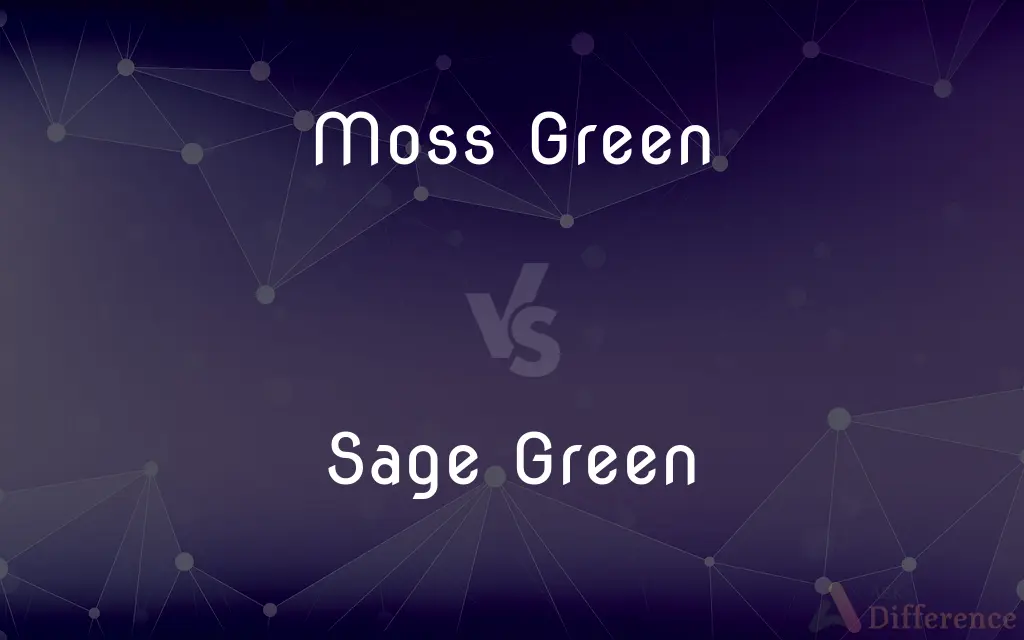Moss Green vs. Sage Green — What's the Difference?
By Maham Liaqat & Fiza Rafique — Published on March 5, 2024
Moss Green is a rich, dark green with earthy undertones, evoking dense forests, while Sage Green is a muted, grayish-green, reminiscent of the sage plant and often associated with tranquility.

Difference Between Moss Green and Sage Green
Table of Contents
ADVERTISEMENT
Key Differences
Moss Green, with its deep and vibrant hue, draws inspiration from the lushness of moss-covered landscapes. This color is associated with nature, growth, and renewal. In contrast, Sage Green, a lighter and more subdued green, carries a sense of calmness and elegance. Its understated quality makes it a popular choice for interior design, promoting a serene and inviting atmosphere.
The intensity of Moss Green makes it a bold choice for accents and focal points in design projects. Its depth can add dimension and a touch of drama to spaces and objects. Sage Green, however, is often used as a neutral background color, blending seamlessly with a wide range of palettes to create a soft, cohesive look.
In terms of application, Moss Green is favored in environments where a connection to nature and a sense of vitality are desired. It's commonly found in outdoor gear, garden design, and adventurous branding. Sage Green, on the other hand, is preferred in minimalist and contemporary designs, especially in home decor, fashion, and branding that aims for a chic, understated vibe.
The psychological impact of these colors also differs. Moss Green is energizing and can stimulate feelings of liveliness and creativity, making it suitable for spaces intended for activity and inspiration. Sage Green, with its calming effect, is ideal for spaces meant for relaxation, meditation, and tranquility, such as bedrooms and spas.
Both Moss Green and Sage Green embody the versatility and beauty of green in different ways. While Moss Green brings an earthy robustness, Sage Green offers a gentle, sophisticated air, demonstrating the spectrum of emotions and styles that green can convey.
ADVERTISEMENT
Comparison Chart
Hue
Darker, vibrant
Lighter, muted
Inspiration
Dense forests, moss
Sage plant, earthy tones
Usage in Design
Accents, nature themes
Neutral backgrounds, minimalist themes
Psychological Impact
Energizing, stimulating
Calming, soothing
Popularity
Outdoor, adventurous settings
Contemporary, tranquil spaces
Compare with Definitions
Moss Green
Popular in outdoor and nature-themed designs.
Their moss green branding reflects the company's commitment to environmental causes.
Sage Green
Acts as a soft, neutral palette in design.
Sage green walls served as a subtle backdrop for the vibrant art.
Moss Green
Rich and vibrant, suitable for making bold statements.
She wore a moss green dress to stand out in the crowd.
Sage Green
Frequently used in minimalist and contemporary themes.
The sage green sofa is a key piece in their minimalist living room design.
Moss Green
Often associated with growth and renewal.
The moss green walls of the office were chosen to stimulate creativity.
Sage Green
Associated with tranquility and elegance.
Her sage green scarf added an elegant touch to her outfit.
Moss Green
A dark, earthy green reminiscent of forest moss.
The moss green throw pillow added a touch of nature to the room.
Sage Green
A muted, grayish-green resembling the sage plant.
The sage green kitchen cabinets created a calming atmosphere.
Moss Green
Symbolizes vitality and natural beauty.
The moss green curtains brought life to the otherwise neutral room.
Sage Green
Ideal for serene and sophisticated spaces.
They chose sage green for the bedroom to enhance its tranquility.
Moss Green
A moderate to dark yellow, olive, or grayish green.
Sage Green
Of the gray-green color of sage leaves
Common Curiosities
Which color is more popular in fashion?
Both are popular, but Sage Green is more prevalent in fashion for its versatile and understated elegance.
Is Moss Green or Sage Green better for small spaces?
Sage Green is typically better for small spaces due to its lightness and ability to make spaces appear larger and more open.
Do these colors have any cultural significance?
Both colors are deeply rooted in nature, symbolizing growth, renewal (Moss Green), and tranquility and wisdom (Sage Green), but specific cultural significances can vary.
Are there any industries where one color is preferred over the other?
Moss Green is often preferred in outdoor and adventure-related industries, while Sage Green is favored in interior design and wellness industries.
Can Moss Green and Sage Green be used together in design?
Yes, they can complement each other well, with Moss Green providing depth and Sage Green offering a soothing backdrop.
Which color is easier to match with other colors?
Sage Green, due to its muted and neutral qualities, making it easier to integrate into a variety of color schemes.
Can Moss Green be used in minimalist designs?
Yes, but sparingly, as its boldness can overpower minimalist aesthetics unless carefully balanced.
How do seasonal trends affect the popularity of these colors?
Seasonal trends can influence the popularity, with Moss Green seeing more use in autumn and winter, and Sage Green in spring and summer.
Are these colors suitable for all seasons?
Yes, both colors can be adapted to various seasonal palettes, with Moss Green often used in fall and winter, and Sage Green in spring and summer.
Can these colors influence mood?
Absolutely. Moss Green can energize and stimulate, while Sage Green can calm and soothe, making them suitable for different purposes and spaces.
Is Sage Green a good choice for outdoor spaces?
Yes, Sage Green can work well in outdoor spaces, especially in garden design and patio decor, blending with natural surroundings.
Are there any psychological benefits to using Sage Green in living spaces?
Yes, Sage Green is known for its calming properties, potentially reducing stress and creating a serene living environment.
Is Moss Green too dark for interiors?
Not necessarily; it can add depth and richness to a space, especially when used as an accent color.
How do lighting conditions affect the appearance of these colors?
Natural light can enhance the vibrancy of Moss Green and the softness of Sage Green, while artificial light may alter their perceived hues.
Which color works better for a calming bedroom environment?
Sage Green is ideal for creating a calming and relaxing bedroom environment.
Share Your Discovery

Previous Comparison
Vascular Plants vs. Nonvascular Plants
Next Comparison
Green Antifreeze vs. Orange AntifreezeAuthor Spotlight
Written by
Maham LiaqatCo-written by
Fiza RafiqueFiza Rafique is a skilled content writer at AskDifference.com, where she meticulously refines and enhances written pieces. Drawing from her vast editorial expertise, Fiza ensures clarity, accuracy, and precision in every article. Passionate about language, she continually seeks to elevate the quality of content for readers worldwide.
















































